Flowers for the Bees
Some ideas for garden flowers for bees


Thank you to the University of Sussex for the following suggestions... Many flowers are attractive to bees, with different types of bee varying in their particular preferences, long-tongued bumblebees such as Bombus hortorum tend to favour deep flowers, and of course short-tongued bumblebees such as Bombus terrestris prefer shallow flowers. Sometimes short-tongued bees rob deep flowers by biting a hole in the side of the flower so they can reach the nectar.
In general herbs and cottage garden perennials are good, and annual bedding plants are best avoided (because they have been intensively bred and have often lost their rewards or become so mishapen that insects cannot get in to them - also, many have been drenched in insecticides , please look at the information from the Nurturing Nature site).
We have added a bee score to give you an idea of how much the bees seem to like to visit these flowers based on observation, you may find some do better than others and sometimes that's down to the varieties within that type … Safe to say, if you see it has lots of little visitors, think about planting more and let others know!
to give you an idea of how much the bees seem to like to visit these flowers based on observation, you may find some do better than others and sometimes that's down to the varieties within that type … Safe to say, if you see it has lots of little visitors, think about planting more and let others know!
Allium siculum, Sicilian honey garlic



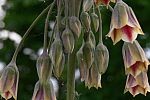 Worth a special mention amongst the alliums, these odd-looking plants drip with nectar and are exceedingly popular with bees, especially red-tailed bumblebees.
Worth a special mention amongst the alliums, these odd-looking plants drip with nectar and are exceedingly popular with bees, especially red-tailed bumblebees.
Allium



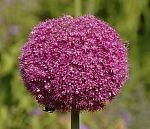
Many garden varieties are available, these are bulb forming perennials. Some are very showy, with huge flower heads.
Antirrhinum, Snapdragon



Like their relative the foxglove, mainly visited by long-tongued bumblebees such as B. hortorum. Short-lived perennials, often grown as annuals.
Apple blossom



Apples are a good source of forage for queens in April and May, and of course the bee visits ensure a good crop. All varieties are good, but some of the crab apples produce particularly profuse flowers.
Aquilegia



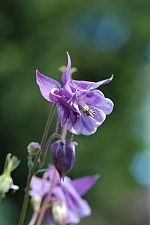
A lovely herbaceous plant, flowers in spring. Nectar is hidden at the end of very long tubes, so it is visited by long-tongued bees - mainly Bombus hortorum - but also robbed by short-tongued bees such as B. terrestris.
Buddliea davidii, Butterfly Bush




A fast growing shrub, to 9', great nectar source for butterflies and popular too with bumblebees. you often see young queen Bombus terrestris on this, fattening up before going into hibernation in July/August.
Comfrey, Symphytum officinale






A very hardy perennial, great for the back of a herbaceous border. Very long flowering period, from May to August, and one of the very best plants for bees. Visited by long and short-tongued species, the latter often robbing from holes bitten in the tops of the flowers. Comfrey can also be chopped down regularly and used to make excellent compost. Can grow 5' tall or more, and will smother smaller plants nearby. Doesn't seed readily, but easily propagated if you have one plant by digging it up in winter and splitting the roots into multiple chunks.
Echinops, Globe thistle



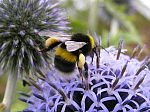
Pretty and unusual perennial, with mauve flowers producing spiky balls on tall stury stems in high summer.
Echium vulgare, Viper's bugloss





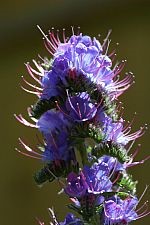
A stunning biennial wildflower growing to about 4', flowering in July and August and absolutely loved by bees of all types for its copious nectar. Likes a sunny, well-drained site, and given this will freely self-seed.
Foxglove, Digitalis purpurea




No cottage garden is complete without foxgloves, hardy biennials that are loved by long-tongued bees such as B. hortorum and B. pascuorum. Tolerate shade well, but flower best in full sun. Freely self-seeds.
Globe artichoke




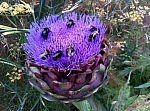
Huge plants, related to thistles, with massive composite flowers that bees flock to in July/August. Grows to 6' or more. You can of course also harvest and eat the buds, but try to leave some for the bees! A favourite with male bumbles.
Heathers, Erica spp.




The spring-flowering garden varieties are particularly popular with early-emerging queen bumblebees, some flowering as early as February when little else is available. The summer-flowering native species are less valuable in a garden setting, though in the wild they are important foodplants for heathland bumblebee species.
Helleborus foetidus


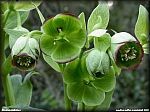
Flower in late winter, great for early emerging queens. Unusual looking herbaceous plants, usually less than 1' tall.
Helianthis, Sunflower




Iconic, very tall annuals, producing spectacular dinner-plate sized flowers that attract many insects, including bumblebees, honeybees and hoverflies.
Hollyhock



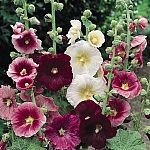
A classic cottage garden plant, giant biennials growing to 10' tall, very popular with male Bombus terrestris. Bees seem to go for the nectar but ignore the plentiful pollen, often becoming smothered in it. Needs staking or growing in dense clumps.
Honeywort, Cerinthe major




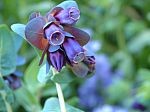
An unusual annual, preferring sunny locations. Produces huge amounts of nectar, some people may find this plant more difficult to grow in their garden.
Jacob's ladder, Polemonium caeruleum


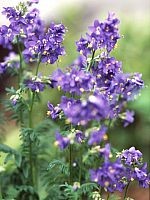
Very pretty little perennial, up to 2' tall, and often overlooked as a plant for bees. Easy to grow perennial, tolerates most conditions, flowers in May-June.
Hyssop, Hyssopus officinale


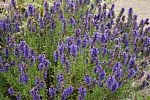
An understated, low-growing perennial herb
Knapweed, Centaurea nigra and Centaurea major



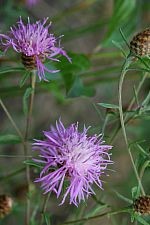
A common meadow wildflower, but takes well to the herbaceous border. Flowers July-August, particularly favoured as drinking posts for male bumblebees.
Lavender





Everybody's favourite, including the bees. A long-lived, hardy perennial (although susceptible to hard frosts in the far north of the UK). Flowers in July and August, and guarantees a cloud of bees. A bit tricky to propogate from seed, can be grown from cuttings.
Lupin


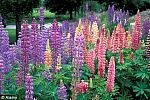
Lovely traditional cottage garden short-lived herbaceous perrenial, easy to propagate from seed. Most varieties produce little nectar, but bees like the bright orange pollen.
Marjoram, Origanum vulgare




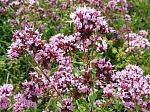
A great all rounder, easy to grow, attractive to heaps of different pollinators, and good for cooking too! Perennial, self-seeds, growing to ~2' tall, loves a sunny position.
Mint, Mentha spp.



There are several wild species in the UK, and many garden varieties. Water mint is great for ponds, and is one of the most attractive for bees. Most flower July-September. Very easy to grow, but can be invasive, so best planted into containers.
Monarda, Bee balm



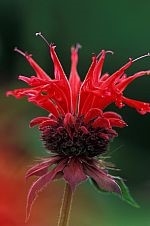
An elegant, showy herbaceous plant, native to North America.
Phacelia tanacetifolia





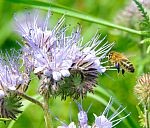
Perhaps the single most attractive plant for bees on the planet! An easy-to-grow annual, flowers in 8-10 weeks from sowing and keeps flowerring for quite a while. Incredibly nectar rich, bees go crazy for it. A North American native, easy to grow from seed. Sometimes sold as a green manure.
Pulmonaria, lungwort



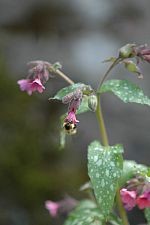
A great early spring nectar resource for hungry queen bumblebees, visited by long-tongued species, especially Bombus pascuorum. An easy perennial, best near the front of a border.
Red Campion

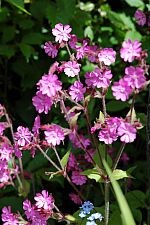
A lovely perennial wildflower with a very long flowering period, from May to September. Visited by Bombus hortorum. Readily seeds, and tolerates shade. Plants are either male or female.
Salix spp., Sallow / pussy willow





Trees, some growing to 30' or more. Sallows are dioecious, being either male or female. Both produce catkins in early spring, and are very important sources of food for queens. The males produce pollen and a little nectar, the females only nectar. Dwarf varieties can be bought for smaller gardens.
Salvia spp., Meadow Clary


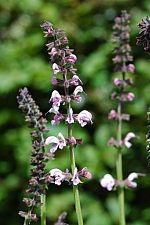
Many garden salvias are available, but I love the wild Meadow Clary, a rare meadow plant. Worth growing just to observe the pollination mechanism; when a bee probes for nectar, this triggers the stamens to curl down and deposit off a blob of pollen onto the bee's back.
Scabious, Knautia spp.




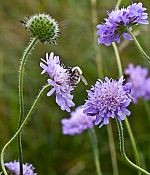
Lovely meadow perennial, one of my particular favourites. Our wild Knautia arvensis is found on chalk downland. There are many garden strains and species. I love the powder-puff blue of the flowers, and bees seem pretty keen too! Flowers in July and August.
Sedum spectabile




A succulent herbaceous perennial, flowering in September, and loved by male bumblebees and butterflies. Grows to about 1', can be spread by splitting plants.
Teasel, Dipsacus fullonum




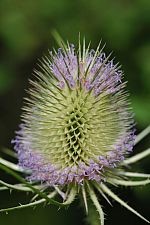
A biennial wildflower, grows very tall (over 6') and rather spiky. However, makes a tremendous plant for the back of a border, the dead flower stems also provide great structure through the winter. Self seeds. Very popular with a broad range of bee species. Flowers July-August.
Thrift


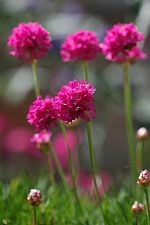
A lovely low-growing perennial plant found in the wild on rocky coastal headlands. Flowers in may and june. One for the rockery or in pots.
Thyme





There are a number of wild and cultivated species. Thymus polytrichus subsp. britannicus is said to be wonderful for bumblebees. Thymes also attract hoverflies and honeybees in abundance. A lovely, low-growing, rambling plant for a pot, the cracks in a patio, or the front of a border.
Tufted vetch, Vicia cracca





A scrambling climber, a wildflower that takes well to the garden, and great for long-tongued bumblebees. Popular with the very rare Bombus distinguendus if you happen to live in the Hebrides or Orkney!
Veronicastrum virginicum



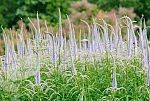
It comes highly recommended. Lovely elegant spires of flowers.
Wisteria




How can you not love wisteria? One of the most beautiful plants, with cascading tresses of purple flowers in spring. A legume, hence related to peas and clovers, a family much loved by bees for their protein-rich pollen. A woody climber, stunning trained along a south-facing wall or over a pergola.




For Additional Information
Please Call 07974 328173